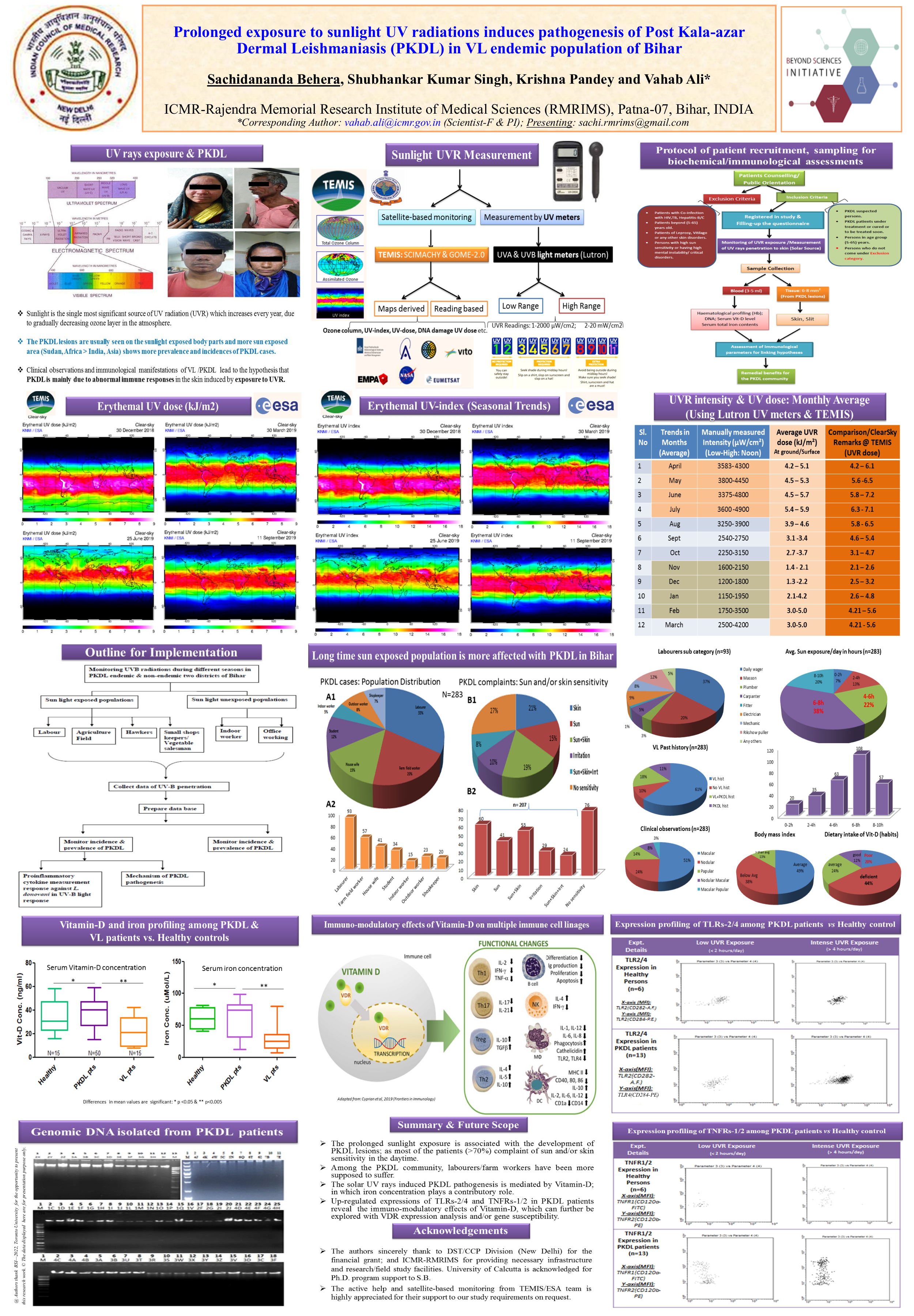Sachidananda Behera
Conference 2022 Poster Presentation
Project title
Prolonged exposure to sunlight UV radiations induces pathogenesis of Post Kala-Azar Dermal Leishmaniasis (PKDL) in VL endemic population of Bihar
Authors and Affiliations
Sachidananda Behera1, Shubhankar Kumar Singh2, Krishna Pandey3, Vahab Ali1*
1. Department of Biochemistry, ICMR-Rajendra Memorial Research Institute of Medical Sciences (RMRIMS), Patna-800007, Bihar, INDIA.
2. Department of Immunology, ICMR-Rajendra Memorial Research Institute of Medical Sciences (RMRIMS), Patna-800007, Bihar, INDIA.
3. Department of Clinical Medicine, ICMR-Rajendra Memorial Research Institute of Medical Sciences (RMRIMS), Patna-800007, Bihar, INDIA
*corresponding author: vahab.ali@icmr.gov.in
Abstract
Background
Post Kala-Azar dermal Leishmaniasis (PKDL) is the post-treatment complication of visceral leishmaniasis (VL), or Kala-azar, which is mainly found in the Indian state of Bihar. VL causes severe fever with hepato- and spenomegaly in the patients, leading to death if left untreated. It affects thousands of populations in Bihar, possessing further threat of parasites transmission in the community. However, the VL elimination program in the Indian subcontinent is challenged by the increasing incidence of PKDL, the proposed reservoir of the causative parasites, Leishmania donovani. Among other factors of PKDL etiology, environmental factor such as vector density is important; and the occurrence of PKDL lesions on sun-exposed body parts implicates the role of solar UV radiations (UVR) in PKDL pathogenesis which is unexplored so far. The increasing UV rays from the sunlight to the ground surface, due to depletion of ozone layer, is a matter of concern for the PKDL patients who habitually work under the sun for long time.
Methods
With the aim to evaluate the impact of solar UV rays, we have manually measured the UV radiations using scientific UV meters (Lutron) and also by satellite-based UVR monitoring methods for a period of four years. We have visited to the PKDL patients community and interviewed them individually. As per the EC approved guidelines, the questionnaire-based study of PKDL patients (n=283) was carried out after informed consent. After screening, their blood samples (n=50) and few tissue samples (n=10) were collected for immunological profiling (TLR-2/4, TNFR-1/2, IL-10, IL-12, IFN-G) as well as biochemical assessment (Vitamin-D, %Hb, iron contents) in the laboratory. The seasonal variability data was correlated with the immunological findings to hypothesize the underlying mechanism.
Results
Our data showed highest UV radiations [UV dose >8-9 kJ/m2] during summer and pre-monsoon seasons; lowest UVR data [UV dose <4-5 kJ/m2] in winter. UV rays has pleotropic role in skin immunology and furthermore, Vitamin-D and iron are reported as mediatory bio-chemicals which play immuno-modulatory roles in Leishmania infections. Among the PKDL patients (n=283), 73% of patients (n=207) showed sun and/or skin sensitivity issues and many patients (n=80, 33%) were found as labourers; 20% patients (n=49) as field-workers. The evaluation of serum Vitamin-D and iron concentration in the PKDL cases (n=50) showed biochemical alterations such as higher (>1.2 fold) Vitamin-D level in the PKDL patients than healthy controls. Iron contents was lower (<1.3 fold) than healthy, but in PKDL patients (> 1.6 fold) higher than VL cases. In addition, up-regulation of TLR-2/4 (>1.5-2 fold) and marginally high expression of TNFR-1/2 were found in PKDL patients than healthy controls by FACS analyses (n=21).
Conclusions
The majority of patients with PKDL complained of sun and/or skin sensitivity under the solar light containing (6%) UV rays. Our study demonstrated that laborers and farm workers develop PKDL lesions, probably due to higher exposure of solar UVR every day, particularly in the VL endemic population. The significant alterations of IL-10, IL-12 and IFN-G along with TLR-2/4 & TNFR-1/2 decipher the role of UVR induced PKDL pathogenesis in Bihar. Our study attempts of giving advisory to PKDL patients to avoid intense sun exposure during and post- treatment, so as to reduce the disease incidence in India.

